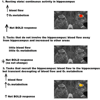How and when the fMRI BOLD signal relates to underlying neural activity: the danger in dissociation
- PMID: 20026191
- PMCID: PMC3546820
- DOI: 10.1016/j.brainresrev.2009.12.004
How and when the fMRI BOLD signal relates to underlying neural activity: the danger in dissociation
Abstract
Functional magnetic resonance imaging (fMRI) has become the dominant means of measuring behavior-related neural activity in the human brain. Yet the relation between the blood oxygen-level dependent (BOLD) signal and underlying neural activity remains an open and actively researched question. A widely accepted model, established for sensory neo-cortex, suggests that the BOLD signal reflects peri-synaptic activity in the form of the local field potential rather than the spiking rate of individual neurons. Several recent experimental results, however, suggest situations in which BOLD, spiking, and the local field potential dissociate. Two different models are discussed, based on the literature reviewed to account for this dissociation, a circuitry-based and vascular-based explanation. Both models are found to account for existing data under some testing situations and in certain brain regions. Because both the vascular and local circuitry-based explanations challenge the BOLD-LFP coupling model, these models provide guidance in predicting when BOLD can be expected to reflect neural processing and when the underlying relation with BOLD may be more complex than a direct correspondence.
Figures


References
-
- Amaral D, Lavenex P. Hippocampal Neuroanatomy. In: Andersen P, Morris M, Amaral D, Bliss T, O'Keefe J, editors. The Hippocampus Book. New York: Oxford University Press; 2007.
-
- Attwell D, Laughlin SB. An energy budget for signaling in the grey matter of the brain. J Cereb Blood Flow Metab. 2001;21:1133–1145. - PubMed
Publication types
MeSH terms
Substances
Grants and funding
LinkOut - more resources
Full Text Sources
Medical

